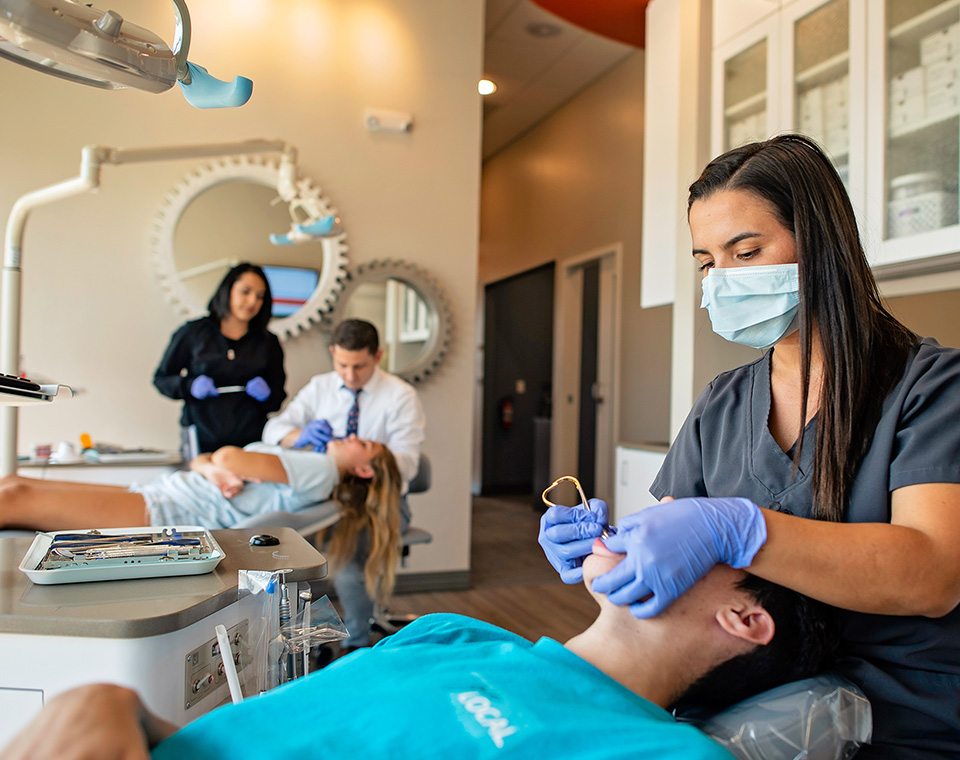Foods To Eat The First Week With Braces

Orthodontic treatment is of paramount importance in our overall health. It encompasses various options, such as braces or clear aligners, to shift teeth into proper alignment, resulting in better appearance and oral health.
The success of orthodontic treatment is heavily dependent on patient compliance, as happens with almost every other medical treatment.
Compliance refers to following the orthodontist’s instructions regarding wearing appliances, maintaining oral hygiene, attending scheduled appointments, and adhering to dietary restrictions.
Compliance significantly impacts treatment progress and effectiveness. Consistently wearing braces or aligners as prescribed ensures the timely achievement of desired tooth movements and bite corrections.
Failure to comply may result in treatment delays, compromised results, or the need for additional interventions, which often means more money.
Maintaining proper oral hygiene is an essential part of patient compliance. Complying with oral hygiene practices, such as regular brushing, flossing, and using recommended cleaning tools, helps prevent tooth decay, gum disease, and other oral health issues.
Compliance also contributes to patient comfort and safety. Following guidelines on appliance wear and seeking professional assistance promptly in case of discomfort or emergencies minimizes the risk of complications or injuries.
The long-term stability of treatment outcomes depends on compliance. Wearing retainers as instructed after active treatment is what helps maintain the results and prevent relapse.
Active patient participation and commitment are crucial for optimizing the effectiveness, efficiency, and stability of orthodontic treatment. By diligently following orthodontic instructions, patients can achieve a beautiful, healthy smile that lasts.
What Are the Orthodontic Treatment Options Available? – Orthodontist, Enid
Traditional Braces, Enid
Traditional braces are the most common type of orthodontic braces. They even have TV shows written about them.
Conventional braces are metal brackets that are bonded to the teeth and connected with metal archwires. These braces are adjustable and require periodic tightening by the orthodontist.
Self-Ligating Braces, Enid
Enid Self-ligating braces Enid functions similarly to traditional braces but uses special brackets that do not require elastic bands or metal ties to hold the wire in place.
Instead, the brackets have built-in clips that secure the wire, reducing friction and allowing for more efficient tooth movement. This type of dental brace often requires fewer adjustments and can be easier to clean.
Clear Ceramic Braces, Enid
Enid Ceramic braces are similar in design to traditional braces but use tooth-colored or clear brackets instead of metal brackets. This makes them less noticeable.
However, ceramic braces can be more prone to staining and may require extra care to maintain their appearance.
Types of Clear Aligners
In-office clear aligners, such as Invisalign or Clear Correct, count with orthodontists who oversee the treatment process.
These aligners are custom-made using advanced technology, and an orthodontist will design and monitor the treatment plan. In-office clear aligners offer personalized treatment, professional supervision, and comprehensive dental care.
On the other hand, in-mail clear aligners, such as SmileDirectClub or Byte, are a more flexible alternative where patients receive a treatment kit via mail and perform the treatment remotely without in-person dental supervision.
Patients take their dental impressions or scans at home with their kits and send them to the company, which then creates and delivers a series of aligners.
While remote dental professionals oversee the treatment, the level of in-person monitoring and effectiveness may reduce in comparison to in-office clear aligners.
Each type of orthodontic brace and clear aligner has its advantages and considerations. Making an informed decision before investing money or starting any treatment is essential.
How Long Does Braces Discomfort Last?
The duration of discomfort experienced with braces varies from person to person. Initially, after having adjustments in your braces, it is common to experience some discomfort or soreness in the teeth and gums.
This discomfort is usually temporary and can last for a few days to a week as the teeth adjust to the new pressure and the mouth adapts to the presence of the braces.
In contrast, Invisalign aligners generally offer less discomfort compared to traditional metal braces. This is primarily because Invisalign aligners smooth plastic molds and do not have any sharp brackets or wires that can irritate the oral tissues.
While some mild pressure or discomfort may be felt during the initial days of wearing a new set of aligners, it tends to be less noticeable and subsides quickly.
The advantage of Invisalign is that the aligners are removable, allowing for more comfortable eating and oral hygiene practices. This means that there are no dietary restrictions as there are with traditional braces, and maintaining oral hygiene is more convenient since the aligners can be easily removed for brushing and flossing.
Every orthodontic treatment in Enid can involve some level of discomfort as teeth are moving gradually into their proper positions. However, Invisalign aligners generally offer a more comfortable experience due to their smooth design and the ability to remove them from certain activities.
How Painful Are Braces?
The level of pain or discomfort varies, but it is generally manageable and temporary.
When the braces are first placed or adjusted, it is common to feel mild pain, sensitivity, and discomfort in the teeth and gums. Patients often describe it as a dull ache or soreness. Over-the-counter pain relievers, such as acetaminophen or ibuprofen, can help alleviate the symptoms.
Certain activities or foods can exacerbate the discomfort. Eating hard, chewy, or sticky foods can increase sensitivity, as can biting or putting excessive pressure on the braces.
Nevertheless, be sure that as the treatment progresses and the teeth gradually adjust, the discomfort will diminish.
What to Eat With Braces the First Week?
Because of the reasons this article mentions above, during the first week of having braces, it’s important to stick to soft, non-chewy, and non-sticky foods to minimize discomfort and avoid damaging the braces.
A list of foods that are generally safe and easy to eat are:
- Soft Fruits: Bananas, sliced apples (without the skin), mashed berries, and seedless grapes.
- Cooked Vegetables: Steamed or boiled carrots, peas, beans, and soft-cooked potatoes.
- Soft Grains: Cooked rice, pasta, and oatmeal.
- Diary Products: Yogurt, pudding, soft cheeses, and milk-based drinks.
- Proteins: Soft-cooked chicken, fish, eggs, tofu, and smooth peanut butter.
- Soups and Broths: Vegetable or chicken broth, pureed soups, and creamy soups.
- Soft Treats: Ice cream, popsicles, gelatin, soft cookies, and milkshakes (without nuts or hard toppings).
- Now, there are some foods you need to avoid during the first days of treatments and some during the whole process:
- Hard Fruits and Vegetables: Apples (whole), carrots (raw), corn on the cob, and crunchy lettuce.
- Sticky foods: Chewing gum, caramel, toffee, gummies, and sticky chocolates.
- Hard Snacks: Pretzels, popcorn, nuts, and hard candies.
- Tough Meats: Steaks, jerky, and tough cuts of meat.
- Crunchy Foods: Chips, hard taco shells, and hard cookies.
You can still eat yummy foods and maintain a balanced diet while ensuring you’re being mindful of the texture and consistency of the foods you choose.
Recipes for the First Week With Braces
To inspire your creativity in the kitchen, here’s a list of 3 delicious and easy recipes for you:
Creamy Vegetable Soup
Ingredients:
- 2 cups mixed vegetables (carrots, peas. corn);
- 1 small onion, chopped;
- 2 cloves garlic, minced;
- 3 cups vegetable or chicken broth;
- 1 cup milk or cream;
- Salt and pepper to taste.
Instructions:
- In a pot, sauté the chopped onion and minced garlic until fragrant.
- Add the mixed vegetables and cook for a few minutes until slightly softened.
- Pour in the broth and bring it to a boil. Reduce heat and simmer for about 15-20 minutes until the vegetables are tender.
- Using an immersion blender or regular blender, blend the mixture until smooth.
- Return the soup to the pot, stir in the milk or cream, and heat gently.
- Season with salt and pepper to taste. Serve warm, and enjoy the comforting soup.
Soft Chicken Stir-Fry
Ingredients:
- 2 boneless, skinless chicken breasts, thinly sliced;
- 1 cup mixed vegetables (bell peppers, broccoli, snap peas);
- 2 tablespoons soy sauce;
- 1 tablespoon olive oil;
- 1 clove garlic, minced;
- Salt and pepper to taste.
Instructions:
- Heat the olive oil in a pan over medium heat. Add the mince3d garlic and sauté for a minute until fragrant.
- Add the sliced chicken to the pan and cook until no longer pink, stirring occasionally.
- Add the mixed vegetables and continue cooking for a few minutes until they are tender-crisp.
- Stir in the soy sauce and season with salt and pepper to taste.
- Cook for an additional minute or two until everything is well combined and heated through.
- Serve the stir-fry over cooked rice or noodles for a satisfying meal.
Banana Yogurt Smoothie
Ingredients:
- 1 ripe banana;
- 1 cup yogurt (any flavor);
- 1/2 cup milk;
- 1 tablespoon honey (optional);
- Ice cubes (optional);
Instructions.
- Peel the banana and break it into smaller pieces.
- In a blender, combine the banana, yogurt, milk, and honey (if desired).
- Blend until smooth and creamy. Add ice cubes if you prefer a chilled smoothie.
- Pour into a glass and enjoy this refreshing and nutritious drink.
Orthodontist, Enid
Enid Orthodontic treatment takes time and patience, but you shouldn’t miss the opportunity to protect your oral health because of this.
Clear braces Enid, self-ligating braces (Enid), and clear aligners Enid are new technologies that can improve the patient’s experience.
Schedule an appointment with Dr. Williams and start giving proper care to your teeth.


